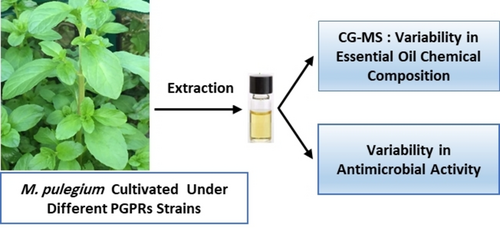Variability in Chemical Composition and Antimicrobial Activity of Mentha pulegium L. Essential Oil, Cultivated under Different Plant Growth Promoting Rhizobacteria
Abstract
The aim of present work was to study the essential oil chemical composition and antimicrobial activity of cultivated Mentha pulegium L. under different plant growth promoting rhizobacteria (Pseudomonas fluorescens, Bradyrhizobium sp. and Sinorhizobium meliloti) individually and in consortium. Yield, in plants inoculated with Bradyrhizobium sp. and S. meliloti in consortium, increase significantly relative to control plants. GC and GC/MS analyses pointed to a qualitative and quantitative variability of components. The investigated essential oils were clustered into three chemotypes: piperitenone/1,8-cineol (40.9/29.4 %) chemotype in plants inoculated with Bradyrhizobium sp. individually, S. meliloti individually, and Bradyrhizobium sp. and S. meliloti in consortium, piperitone/menthone (41.8/33.8 %) chemotype in plants inoculated with P. fluorescens individually, P. fluorescens and Bradyrhizobium sp. in consortium, and P. fluorescens and S. meliloti in consortium and pulegone/menthol (47.9/31.5 %) chemotype in control plants. The antimicrobial activity, carried out by the disc diffusion method and the determination of the Minimum Inhibitory Concentration (MIC) against ten microorganisms, varied significantly according to the tested microorganism and the rhizobacterial species used individually or in consortium (inhibition zone: 8.5–33.5 mm; MIC: 0.25–2.5 μL/mL). Our findings provided useful indications to select interesting chemotype within M. pulegium, especially in perspective of its cultivation.
Graphical Abstract
Conflict of interest
The authors declare no conflict of interest.
Open Research
Data Availability Statement
Data sharing is not applicable to this article as no new data were created or analyzed in this study.





